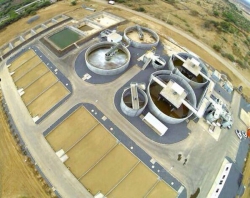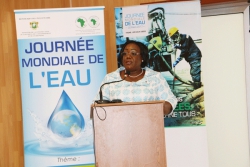DRINKING WATER QUALITY * What is aggressive water and why is it treated? 1-1 Aggressive wa...
Aggressive water is water that has some excess of carbon dioxide. It is also called carbon anhydride or carbonic acid. In order to foster an equilibrium state and avoid any deposit of chemical elements into water, there is a need for the presence of carbon dioxide.
But as it remains in quantities higher than those required for maintaining that equilibrium, the resulting excess termed as being aggressive will bite the existing calcium carbonate and bring about corrosion of the metallic materials contained in water supply pipes and storage tanks. The deterioration of the materials making up such pipes is the cause for a speedy reduction in service life of such facilities, thus giving rise to leaking and breakage all along the water distribution system. The corrosion of the distribution and storage equipments leads to the formation of rust – depending on the manufacturing material used- that is responsible for the red water, bad taste and smell water users complain about.
The aggressive carbon dioxide contained into drinking water being not the only cause of toxicity in users, the secondary effect caused by it in the course of water distribution through the pipes gives rise to a situation whereby its being removed is at times deemed indispensable so as to provide local populations with fully good drinking water.
What types of treatment should be used a aggressive water?
When it comes for instance to low-mineralized water, the appropriate treatment will consist in not only reducing the corrosivity of water but also upgrading the level of mineralization. While still considering the level of carbon dioxide present in the water being treated, physical treatment (aeration, forced de-gassing, spraying etc.) may prove to be necessary to remove some of the carbon dioxide present before neutralizing the remainder by means of alkaline earth products. In case the water is naturally mineralized and aggressive, any physical treatment will suffice to restore carbonic equilibrium.
The final end of such a treatment is to produce water nearing calc-carbonic equilibrium, i.e. some slightly calcific water with a Glossary Link pH related to its equilibrium state. (LEROY, 1999) so as to avoid any occurrence of corrosion coupled with red waters and untimely deterioration of existing pipes.How do non conventional resources contribute to water resource mobilization?
What is the future of water desalination in Tunisia?
In order to avoid overexploitation of groundwater as per the requirements of sustainable development, sea water desalination will be playing a major role in the future. The Tunisian authorities have previously called for tenders to build for the first time at Djerba a sea water treatment plant with a capacity of 5,000 m3 /day. This plant will be build before 2010 summertime as part of a concession.
The Tunisian authorities have also planned to build at Mareth another sea water desalination treatment plant of the same capacity to strengthen water resources of drinking water supply systems located at the south east Tunisian region.
What should be done when someone has misgivings about water quality?
The quality of the water tap supplied to users is one of the main issues related to drinking water supply all customers are aware of. This issue should be prioritized by drinking water suppliers and health authorities. Therefore, water suppliers should take appropriate steps so that drinking water may not only satisfy drinkability requirements from a legal point of point but also fully good quality control. Despite all precautions, several causes may account for the alteration of the quality of drinking water and escape the attention of water suppliers. There are as follows:
- Introduction of salted water into supply pipes while breakage is being repaired or as new pipes are maintained or laid.
- Backflow from poorly maintained privately-owned tanks.
- Uncontrolled leaking bringing about waste water in case of subpressure etc.
Should any user lawfully doubt about the quality of tap water, the latter will have to contact the local water utility. In case of need, the department concerned will assign a technical staff on the ground to investigate and possibly collect water intakes and immediately handle the faults discovered.
Sometimes water has temporarily a milk-like appearance; what is it?
This milk-like appearance as water tap runs is not related to the excess of chemicals such as slaked lime, chlorine or alumina sulfate used to treat water, neither to any other substance unlike the general opinion of users. To get the idea across, one has to collect drinking water from a white glass and raise it at eye level.
What can be observed is that water gets clearer bottom-up and provides a boiling appearance from the surface. In actual fact, this milk-like appearance is as a result of the presence of a few air bubbles contained in water as they resurface following intake few seconds later. The water subsequently becomes crystal-clear.

 English
English  Français
Français 







